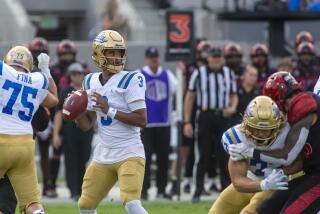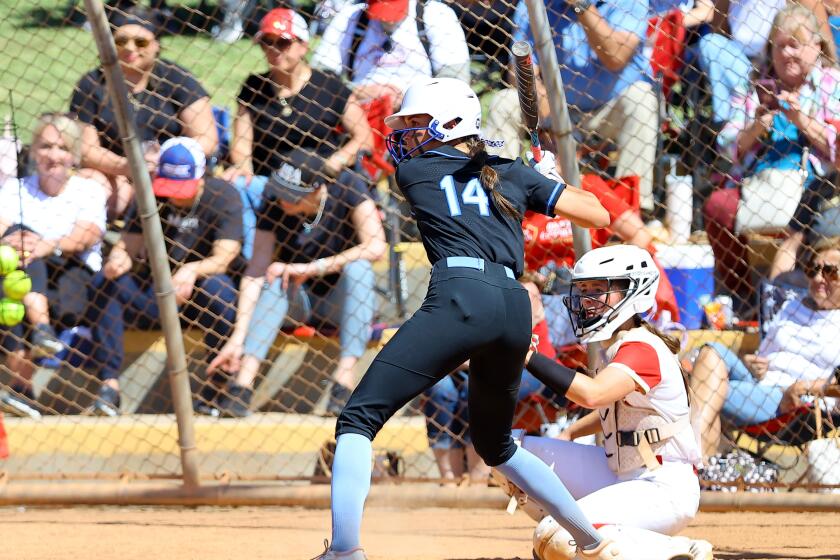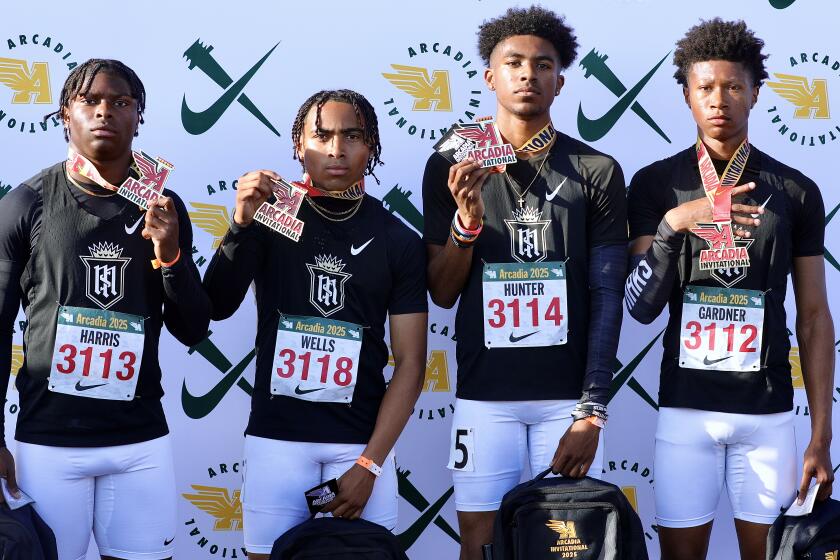Football Recruiting Academic at Virginia
- Share via
CHARLOTTESVILLE, Va. — When Trevor Ryals, an outstanding center on Cincinnati’s legendary Moeller High School football team, was considering colleges in 1986, he ended up settling on the University of Virginia for the most unusual reason.
“I wanted to go someplace where, if football didn’t work out, if I had an accident or blew out my knee, I’d have academics to fall back on,” Ryals said.
Ryals was the kind of football player Virginia almost always attracted: the one who picked the school not because of the football team, but because of everything else, the way most students pick a college.
This is not so unusual at strong academic institutions in prestigious conferences, schools such as Virginia, Stanford, Northwestern and Vanderbilt. But what is so unusual about what’s happening at Virginia this year is that this collection of students who play football happens to be undefeated and ranked second in the nation in the Associated Press poll.
How they came to be so good is a mystery in the outside world and even a bit of a well-kept secret here. George Welsh, the taciturn coach who has lifted the Cavaliers from 1-10 to one and only (almost), shrugs when he begins to talk about it.
Without lowering the academic standards of the team, without changing the schedule, without turning to flowery recruiting language, Welsh has molded a contender by keeping much of the in-state talent in the state and his coaching staff largely intact for nine seasons.
Eleven members of his 1986 recruiting class have blossomed into fifth-year starters. Players who hardly were blue-chippers in high school have turned into future all-Americans. And through it all, he has wondered if what he has worked so hard to achieve is what he and the school really want.
“We’re not going to be in the same league every year that Southern Cal and those guys are,” he said. “And you probably don’t want it here. You don’t want to read about being a football factory. It would be a negative-type thing. The university’s not geared that way. ... If there’s a lot of enthusiasm and we’re selling the stadium out all the time -- that’s all good. But if (the team) starts counting victories or thinking, ‘Wow, we could be undefeated,’ and forgetting what you have to do to do it, then it’s detrimental.”
One of the first questions put to a prestigious school when it finds the Midas touch on the football field is about academics: Might not the school be lowering its standards to win games?
Welsh bristles at the suggestion.
Virginia’s academic standard “hasn’t changed since I’ve been here,” he said. “We have people turned down who have gone on to other conference schools and have gone on to other schools out of the conference that we couldn’t get academically.
“I don’t know why people are saying that now. If we were 2-3 now, instead of 5-0, you probably wouldn’t hear about it. When you get to the bottom line, you have to look at the graduation rate. We still are in the top five or 10 of the country. We and Duke have always led the conference.”
Alan Williams, Virginia’s faculty athletics representative, said there has been “no change” in the football team’s SAT scores or its graduation rate in the past 15 years. The average SAT scores of the football team range from 910 to 1020, Williams said, while the average for all entering students at the school ranges from 1200 to 1220.
The graduation rate for football players who entered in 1984 was 95.6 percent (22 of 23), Williams said, and it usually runs 83 percent to 89 percent. The overall school graduation rate was 89 percent, he said. Only Duke (96 percent, 24 of 25) had a higher football graduation rate among all CFA schools, Williams said.
The school also does not allow Proposition 48 students now, although it did admit two in 1985. One flunked out, the other stayed in school.
“If academics were being overlooked, you know the university wouldn’t stand for it,” said defensive lineman Joe Hall, a fifth-year graduate student, one of nine graduate students on the team. “We are under a microscope with the university.”
It is this academic orientation that rules the thoughts of many football players. Hall, a Washington Post All-Met selection who could have gone to Michigan, UCLA or Tennessee, said bluntly that he came to Virginia for its academics and social life -- and the possibility of going to a bowl game sometime during his years here.
“I wasn’t coming here to try to win a national championship,” Hall said.
Nor did Welsh come to Virginia from Navy for that reason.
“If I felt like I had to go somewhere to be a national-championship contender or top 10 football team, I certainly wouldn’t have come here,” he said.
But he was looking for measurable amounts of success. Taking over a 1-10 team from Dick Bestwick, he imagined he could “wave a magic wand and get players to compete and win.
“But we didn’t. That took us a year. They just didn’t know how to win, how to pay the price, how to be in position to win.”
In one of his first scrimmages, Welsh counted the number of players who could not practice. He reached 33. None was a freshman he and his staff had recruited; they all were upperclassmen who were not used to practicing in pain.
Recruiting was equally challenging in those early years.
“I underestimated the problem after being at Navy and having three bowl teams,” Welsh said. “Once we came here, (a recruit) would say, ‘Well, it’s Virginia,’ and they didn’t even visit.”
After going 2-9 in 1982, Welsh turned things around and went 6-5 in 1983 and 8-2-2 in 1984, including a victory over Purdue in the Peach Bowl. That bowl trip, the first in the school’s history, became the cornerstone of Welsh’s recruiting strategy.
“That helped us a lot to dispel the losing image and get better players, especially locally, in the D.C. area,” he said.
By now, his team was stocked with several future NFL stars, including offensive tackle Jim Dombrowski, linebacker Jeff Lageman, strong safety Lester Lyles and quarterback Don Majkowski. In 1985, the Cavaliers dropped back to 6-5, and fell even further in 1986, to 3-8. But athletes still came, including quarterback Shawn Moore as part of the exceptional class of 1986, and wide receiver Herman Moore in 1987.
Herman Moore, not particularly highly recruited out of George Washington High in Danville, Va., was told by rival schools not to come to Virginia.
“You have guys there who expect to lose,” Moore said rival coaches told him. “Virginia’s definitely not going to win anything. Look at their record; they’re on the downswing.”
Moore visited Virginia anyway, liked the place, and signed up.
“Virginia never said anything bad about any of the others,” he said.
Welsh soon was signing Terry Kirby, a Tabb, Va., running back considered the best high-school player in the nation in 1988. Defensive end Chris Slade, Kirby’s high-school teammate and a prep all-America, came along as well.
Good things just kept happening. In 1987, there was the All American Bowl and an 8-4 record; in 1988, no bowl, but 7-4; in 1989, the Florida Citrus Bowl and a 10-3 mark.
“Now, kids want to come to Virginia,” said Hall. “You don’t have to talk them into coming. For a long time, we had to chase after people. We can choose people now.”
More to Read
Go beyond the scoreboard
Get the latest on L.A.'s teams in the daily Sports Report newsletter.
You may occasionally receive promotional content from the Los Angeles Times.










